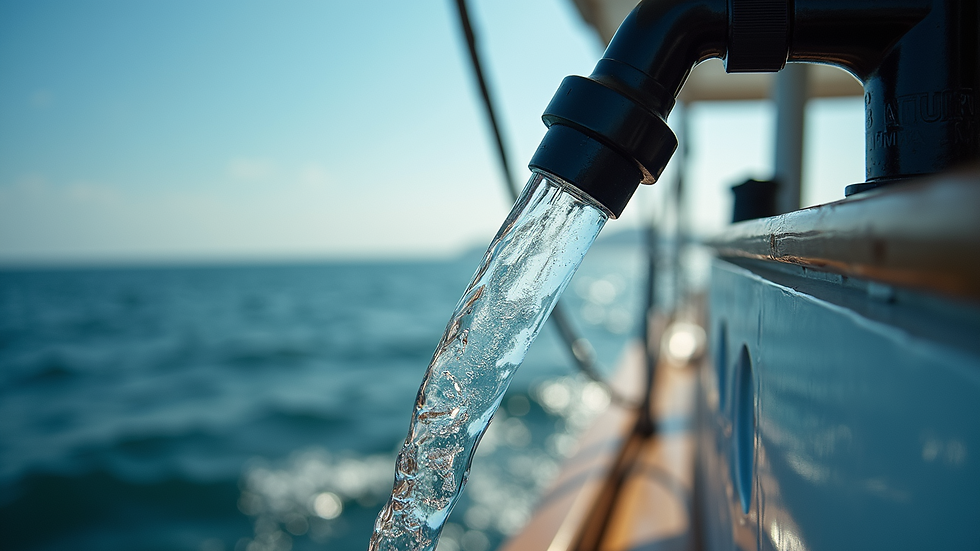Why Reverse Osmosis is Key for Freshwater on Board
- Omri Farbstein

- Sep 29
- 3 min read
Freshwater is essential for any boat trip, whether for drinking, cooking, or cleaning. However, carrying enough freshwater on board can be challenging, especially for longer journeys. This is where reverse osmosis technology becomes a game-changer. It allows boats to produce clean, safe freshwater directly from seawater or other sources, ensuring a reliable supply no matter how far you travel.
Understanding Reverse Osmosis and Its Benefits on Boats
Reverse osmosis (RO) is a water purification process that removes contaminants by forcing water through a semipermeable membrane. This membrane blocks salts, bacteria, and other impurities, leaving behind clean, drinkable water. On boats, this technology is invaluable because it reduces the need to store large quantities of freshwater, saving space and weight.
Some key benefits of reverse osmosis on boats include:
Consistent freshwater supply: No need to rely on shore facilities or carry heavy water tanks.
Improved water quality: Removes harmful salts, chemicals, and microorganisms.
Cost-effective: Reduces expenses related to purchasing and transporting bottled water.
Environmentally friendly: Minimizes plastic waste and reliance on external water sources.
Installing a reverse osmosis system on your vessel can transform your onboard water management, making longer trips more comfortable and sustainable.

How Reverse Osmosis Works on Boats
The reverse osmosis process on boats typically involves several stages:
Pre-filtration: Removes larger particles like sand, dirt, and debris to protect the RO membrane.
High-pressure pump: Pushes seawater or brackish water through the membrane at high pressure.
RO membrane: Filters out salts, bacteria, viruses, and other contaminants.
Post-treatment: Sometimes includes UV sterilization or mineral addition to improve taste and safety.
The system produces two streams: purified freshwater and a concentrated brine waste. The freshwater is stored in tanks for use, while the brine is discharged back into the sea.
To maintain efficiency, regular cleaning and membrane replacement are necessary. Proper installation and maintenance ensure the system runs smoothly and delivers high-quality water consistently.
For those interested in exploring options, reverse osmosis for boats offers specialized solutions designed for marine environments.

Does Reverse Osmosis Work on Sea Water?
Yes, reverse osmosis is highly effective at desalinating seawater. The RO membrane can remove up to 99% of salt and other dissolved solids, making seawater safe for drinking and other onboard uses. This capability is crucial for boats traveling in open waters where freshwater sources are scarce or unavailable.
However, seawater desalination requires more energy and robust equipment compared to treating brackish or freshwater. The high salt content means the system must operate at higher pressures, and membranes may need more frequent maintenance.
Despite these challenges, modern marine reverse osmosis systems are designed to handle seawater efficiently. They provide a reliable freshwater source, reducing dependence on shore supplies and increasing self-sufficiency.

Practical Tips for Using Reverse Osmosis Systems on Boats
To get the most out of your reverse osmosis system, consider the following practical tips:
Choose the right system size: Match the system capacity to your boat’s water consumption needs.
Regular maintenance: Clean filters and membranes as recommended to prevent clogging and damage.
Monitor water quality: Use TDS (total dissolved solids) meters to check water purity regularly.
Energy management: Ensure your boat’s power supply can handle the system’s energy demands.
Proper installation: Work with professionals to install the system securely and efficiently.
By following these guidelines, you can maximize the lifespan and performance of your reverse osmosis system, ensuring a steady supply of freshwater on board.
The Future of Freshwater Production on Boats
As technology advances, reverse osmosis systems are becoming more compact, energy-efficient, and user-friendly. Innovations such as solar-powered RO units and smart monitoring systems are making freshwater production on boats even more accessible.
Investing in a high-quality reverse osmosis system not only improves your onboard water supply but also contributes to sustainable boating practices. By reducing reliance on bottled water and shore-based sources, you help protect marine environments and reduce plastic waste.
Whether you are a casual sailor or a long-distance cruiser, embracing reverse osmosis technology is a smart step toward water independence and environmental responsibility.
By integrating reverse osmosis technology, boats can ensure a reliable, safe, and sustainable freshwater supply. This innovation is key to enhancing onboard comfort and extending the possibilities of marine travel.





Comments